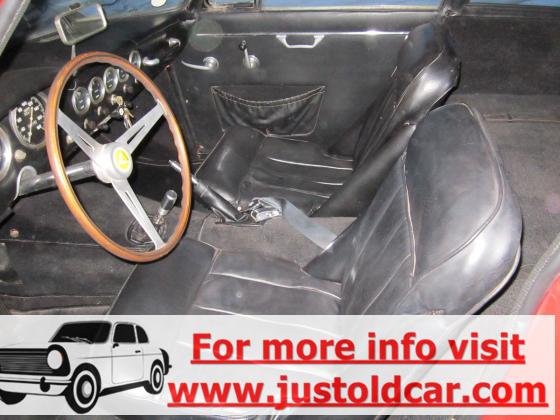$56,000.00
1964 Apollo 5000 GT Sport Coupe
Posted Feb 19, 2025 | Hits: 23
Make:
Apollo
Model:
5000 GT
Country:
USA
State:
MI
City:
Livonia
Zip:
48150
Body Style:
Fastback
Year:
1964
Mileage:
35650
Miles
Transmission:
Manual
Engine:
250 hp 5L Aluminum head Buick V8
Fuel:
Gasoline
Doors:
2
Color:
Red
Condition:
Used
1964 Apollo 5000 GT. Excellent condition for an unrestored 60 year old car. Fresh valve job, new springs and exhaust system. Original muffler. No rust.
The guiding light behind the Apollo was engineer Milt Brown, who grew up as a car-crazy kid in California during the 1950s. He had a high-school friend named Ron Plescia who shared his affliction, and the two of them often schemed about building their own sports car. In the 1950s, Brown took a "car-guy vacation" to Europe to visit famous sports car factories and take in as many races as possible. After returning home, Brown embarked on his first manufacturing project, producing six of his Apache Formula Junior racing cars in 1960. These Fiat- and Peugeot-powered racers were very attractive, but in the rapidly evolving F-Jr class, they were soon outclassed (in 2004, one was lovingly restored and run in the prestigious Monaco vintage F-Jr race).
Brown returned to Europe in the early 1960s for his honeymoon and couldn't resist stopping by the Monaco Grand Prix, where he met Hungarian-born Frank Reisner. Reisner was born in 1932, and his parents had fled to Canada during WWII. He earned a degree in chemical engineering from the University of Michigan before getting a job in the paint industry. When he took a vacation to Italy in 1958, he and his wife decided to put down roots and get involved in cars. Reisner's company, Carrozzeria Intermeccanica, built specialty cars in Turin, Italy. The low cost of labor, allied with a ready supply of skilled fabricators and bodymen, meant Reisner could build complete cars for much less than they could be made in America. There was no assembly line as such, only apparent chaos as a horde of bodymen hammered the steel body panels into shape over tree stumps with wooden mallets. Brown and Reisner made a deal, and Brown went to work on a design for his new car, which his wife suggested should be named Apollo for the Greek god of the sun. A new company, International Motor Cars, was set up in Oakland, California, to build and develop the new sports model.
Brown designed a simple steel ladder frame based on parts from the Buick Special. This compact sedan was GM's attempt at a smaller, lighter, more European-inspired econobox. Although the suspension was conventional Detroit practice with A-arms in front and a live axle in back, the new engine was a great design. It was a small (by Detroit standards), 3.5L (215 ci), all-aluminum V-8 with 190 hp. Coupled to a three- or four-speed manual transmission, it was a great choice for a sports car (Morgan, Triumph, MG, and Rover would later use versions of it). Brown's chassis used the Buick front suspension and, in back, a live axle with four locating links. A longer pitman arm was fitted to speed up the steering, along with softer springs and revised suspension geometry.
Brakes were Bendix power discs up front with Chevy drums in back. Dunlop wire wheels with knock-off hubs were standard but Borrani wire wheels were an exotic option. Brown picked up a used Buick with a toasted interior to serve as a donor car for the first chassis, which was constructed in the garage of new partner Ned Davis. The 4-inch-square steel framerails were joined by round Buick crossmembers that mounted the Buick suspension, with a sway bar added for flatter cornering.
The new model was introduced in 1963 as the Apollo 3500GT. With a 97-inch wheelbase and a weight of 2,485 lbs, it was about the same size as a Corvette Sting Ray but considerably lighter. The little Buick V-8 was now pumping out 200 hp (thanks to an increase in compression) and wore a single four-barrel carburetor. With a 3.36:1 final drive ratio, the Apollo GT ran the quarter-mile in 16 seconds flat and accelerated from zero to 60 in 8.4 seconds. This was impressive but not spectacular, being a little slower than a Jaguar XKE and on par with a Sunbeam Tiger. Roadholding was very good considering the pedestrian origins of the suspension and steering, but the Apollo was intended as a comfortable high-speed touring car, not a primitive road rocket.
After building 15 cars, the aluminum Buick was switched to a 250hp, cast-iron, 5L Buick V-8. This was in response to calls for more power and persistent production problems with the aluminum engine. The revised model was named the Apollo 5000GT. A convertible was also introduced, which was as lovely as any Ferrari of the period. The price for the coupe was set at $7,105 with air conditioning, sunroof, and an optional automatic transmission. The body and chassis units were built by Reisner in Turin and shipped to International Motor Cars for engine installation. The first big break was when a California Buick dealership ordered 50 cars. Things were looking up!
Dark TimesThen the storm hit. Sinister Buick corporate types discovered the dealer was re-badging Apollos as Buicks before selling them. This came to a screeching halt and Apollo lost their biggest customer. A succession of "angels" promised, but ultimately failed to deliver the funding needed to increase production to the point of profitability. Thinking they needed a roomier model, Reisner developed a 2+2 model that never got beyond the prototype stage. Although the standard engine was the 5L Buick, some late Apollos received 327 Chevy engines (Brown says Apollo intended to switch to the Chevy). Some were sold without engines, and one of these was fitted with a Ford 289 by its owner. The money problems wouldn't go away and everything ground to a halt in the summer of 1964. Four coupes were sold in kit form to raise capital.
At that time, Vanguard Air Conditioning in Dallas offered to buy the remaining body and chassis units that Reisner had in stock. They were to be assembled in Dallas and called Vetta Ventura GTs. Reportedly 16 coupes and three convertibles were delivered, but only a handful were completed. The remaining Vetta Venturas were sold uncompleted, with eight being assembled by Precision Motors, a Dallas import-car dealership. Although most Vetta Venturas had the 5L Buick engine, like the late Apollos, some were equipped with Chevys.
The guiding light behind the Apollo was engineer Milt Brown, who grew up as a car-crazy kid in California during the 1950s. He had a high-school friend named Ron Plescia who shared his affliction, and the two of them often schemed about building their own sports car. In the 1950s, Brown took a "car-guy vacation" to Europe to visit famous sports car factories and take in as many races as possible. After returning home, Brown embarked on his first manufacturing project, producing six of his Apache Formula Junior racing cars in 1960. These Fiat- and Peugeot-powered racers were very attractive, but in the rapidly evolving F-Jr class, they were soon outclassed (in 2004, one was lovingly restored and run in the prestigious Monaco vintage F-Jr race).
Brown returned to Europe in the early 1960s for his honeymoon and couldn't resist stopping by the Monaco Grand Prix, where he met Hungarian-born Frank Reisner. Reisner was born in 1932, and his parents had fled to Canada during WWII. He earned a degree in chemical engineering from the University of Michigan before getting a job in the paint industry. When he took a vacation to Italy in 1958, he and his wife decided to put down roots and get involved in cars. Reisner's company, Carrozzeria Intermeccanica, built specialty cars in Turin, Italy. The low cost of labor, allied with a ready supply of skilled fabricators and bodymen, meant Reisner could build complete cars for much less than they could be made in America. There was no assembly line as such, only apparent chaos as a horde of bodymen hammered the steel body panels into shape over tree stumps with wooden mallets. Brown and Reisner made a deal, and Brown went to work on a design for his new car, which his wife suggested should be named Apollo for the Greek god of the sun. A new company, International Motor Cars, was set up in Oakland, California, to build and develop the new sports model.
Brown designed a simple steel ladder frame based on parts from the Buick Special. This compact sedan was GM's attempt at a smaller, lighter, more European-inspired econobox. Although the suspension was conventional Detroit practice with A-arms in front and a live axle in back, the new engine was a great design. It was a small (by Detroit standards), 3.5L (215 ci), all-aluminum V-8 with 190 hp. Coupled to a three- or four-speed manual transmission, it was a great choice for a sports car (Morgan, Triumph, MG, and Rover would later use versions of it). Brown's chassis used the Buick front suspension and, in back, a live axle with four locating links. A longer pitman arm was fitted to speed up the steering, along with softer springs and revised suspension geometry.
Brakes were Bendix power discs up front with Chevy drums in back. Dunlop wire wheels with knock-off hubs were standard but Borrani wire wheels were an exotic option. Brown picked up a used Buick with a toasted interior to serve as a donor car for the first chassis, which was constructed in the garage of new partner Ned Davis. The 4-inch-square steel framerails were joined by round Buick crossmembers that mounted the Buick suspension, with a sway bar added for flatter cornering.
The new model was introduced in 1963 as the Apollo 3500GT. With a 97-inch wheelbase and a weight of 2,485 lbs, it was about the same size as a Corvette Sting Ray but considerably lighter. The little Buick V-8 was now pumping out 200 hp (thanks to an increase in compression) and wore a single four-barrel carburetor. With a 3.36:1 final drive ratio, the Apollo GT ran the quarter-mile in 16 seconds flat and accelerated from zero to 60 in 8.4 seconds. This was impressive but not spectacular, being a little slower than a Jaguar XKE and on par with a Sunbeam Tiger. Roadholding was very good considering the pedestrian origins of the suspension and steering, but the Apollo was intended as a comfortable high-speed touring car, not a primitive road rocket.
After building 15 cars, the aluminum Buick was switched to a 250hp, cast-iron, 5L Buick V-8. This was in response to calls for more power and persistent production problems with the aluminum engine. The revised model was named the Apollo 5000GT. A convertible was also introduced, which was as lovely as any Ferrari of the period. The price for the coupe was set at $7,105 with air conditioning, sunroof, and an optional automatic transmission. The body and chassis units were built by Reisner in Turin and shipped to International Motor Cars for engine installation. The first big break was when a California Buick dealership ordered 50 cars. Things were looking up!
Dark TimesThen the storm hit. Sinister Buick corporate types discovered the dealer was re-badging Apollos as Buicks before selling them. This came to a screeching halt and Apollo lost their biggest customer. A succession of "angels" promised, but ultimately failed to deliver the funding needed to increase production to the point of profitability. Thinking they needed a roomier model, Reisner developed a 2+2 model that never got beyond the prototype stage. Although the standard engine was the 5L Buick, some late Apollos received 327 Chevy engines (Brown says Apollo intended to switch to the Chevy). Some were sold without engines, and one of these was fitted with a Ford 289 by its owner. The money problems wouldn't go away and everything ground to a halt in the summer of 1964. Four coupes were sold in kit form to raise capital.
At that time, Vanguard Air Conditioning in Dallas offered to buy the remaining body and chassis units that Reisner had in stock. They were to be assembled in Dallas and called Vetta Ventura GTs. Reportedly 16 coupes and three convertibles were delivered, but only a handful were completed. The remaining Vetta Venturas were sold uncompleted, with eight being assembled by Precision Motors, a Dallas import-car dealership. Although most Vetta Venturas had the 5L Buick engine, like the late Apollos, some were equipped with Chevys.















 Email
Email Share
Share Report
Report Favorite
Favorite




